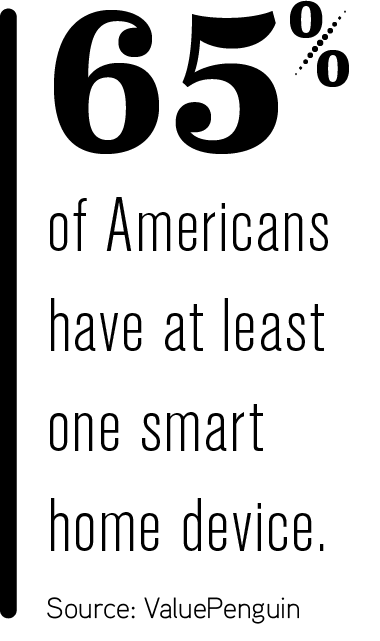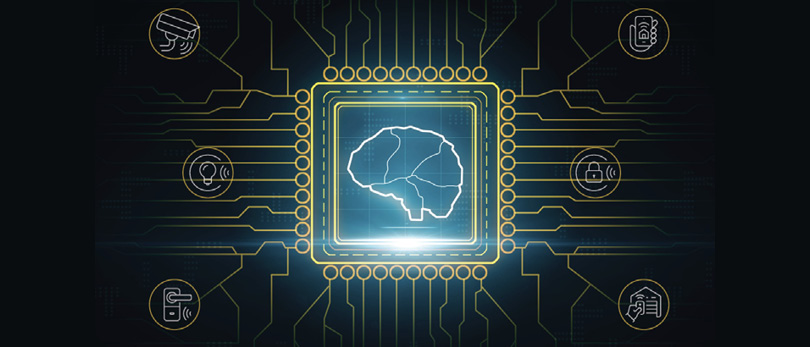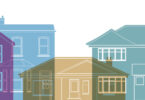Take a look at the best green technologies available to make homes smarter and more efficient
By Michelle Huffman
Smart home devices and green-friendly home building are two trends that have been growing in the housing market for years. But as these two trends coalesce, we’re seeing homebuyers looking specifically for smart devices that improve energy efficiency.

A recent ValuePenguin survey revealed that 65% of Americans have at least one smart home device, and many purchased the smart technology because it’s better for the environment, showing that going green is becoming more popular.
It doesn’t hurt that these devices save homeowners money, too: Smart technologies and real-time energy management systems can decrease energy costs by an average of 15%, according to the New York State Energy Research and Development Authority.
Here’s an overview of some of the green smart tech that buyers and homeowners are looking to have in their homes.
 Smart thermostats
Smart thermostats
Smart thermostats have been important to homeowners for the last 10 years, says Fran Bixler, CRS, of RE/MAX of Naperville in Naperville, Illinois.
The Nest thermostat is the leading product agents are seeing in homes. As you change the temperature, these thermostats learn your schedule and adjust automatically over time.
“People just really want to set it and forget it,” says Khoi Le, CRS, with Hunter Chase Realty in Albuquerque, New Mexico.
However, “if you don’t have a set schedule, these don’t do you much good,” says Steven Donley, CEO of Eco Smart Home Pros, a Muskegon, Michigan-based company that installs many of these devices in homes. “And with so many people working from home, the energy savings and environmental impact is reduced.”
Instead, Donley says that some homeowners are turning to thermostats that are also tied to their security systems, which turn the heat up or down as you come and go.
Smart apps to curtail energy use
Smart apps can help homeowners reduce energy use. Bixler cites two examples: “Consumers download smart apps that track their electricity usage and show them ways to reduce their bills,” she says. “They also install forward-looking infrared (FLIR) apps to see thermal imaging of their homes and find where they need to increase insulation, change out old windows or even add foam insulation/sealer on wall outlets.”
Automated shade systems
One of the more unexpected ways homeowners are using smart tech to save energy is automated shades, Donley says.
With the tap of a button or the use of your voice, you can control the shades across your entire home.
“People don’t think about it as energy control; they think about it in terms of light,” he says. “But with Honeycomb shades, for example, you get an insulation R-factor of 3.2 to 4.3. You’re actually able to get as much insulation value as from the windows themselves.”
Lighting controls
“Lighting controls can reduce energy several different ways,” Donley says. There are lighting kits that connect your home’s lights to an app, like Philips Hue, but that’s not the only option.
Occupancy sensors can turn lights on when you enter and off when you leave a room, which can be especially helpful in pantries and bathrooms. Other controls can automatically set lights at a slightly dimmer level.
“If you take your dim level on the light switch and set it at 75%, it’s approximately a 5% reduction in visible light. Most of the time you don’t notice it, but that can be a 20% savings in electricity,” Donley says.
If you want cutting-edge tech, human-centric lighting, or HCL, is becoming more popular. This system controls the hue of light throughout the day by putting out warm amber light in the morning, switching to blue light during the day and reverting back to an amber light at night, matching natural light and aiding our circadian rhythm. This can boost focus, and help daytime energy and nighttime sleep, Donley says.
Solar panels
Solar panels are also becoming more prevalent across the country, and agents are becoming smarter about them.
“We have 300 days of sunlight [in New Mexico], so solar panels are very popular here,” Le says. “People do have to be aware of the contracts, how they can be transferred, if they have to be paid off in their entirety before that, etc. It’s something that really needs to be looked into.”
If you’re an agent selling properties, make sure to include it in the list of home features because buyers are looking for solar panels and often willing to pay more for them, Le says.
But What About Security?
“With most of this tech, there are security concerns,” Le says. “The average person doesn’t know their camera can be hacked into and their garage door opened.”
Le says that homeowners installing this tech need to look into the security standards and features like two-factor authentication. They should also think about what they would do in the face of a breach. Smart tech users should also consider what’s happening with the data generated by these devices.
“Tech-savvy people are realizing their homes are now delivering data packages to these service providers 24/7 and understand they are the product with a digital identity depending on how many smart products they use,” Bixler says.
Want to develop your technology expertise? Get certified with the Smart Home Certification today. Visit CRS.com/certificates for more information.
Photo: iStock.com/Igor Kutyaev








